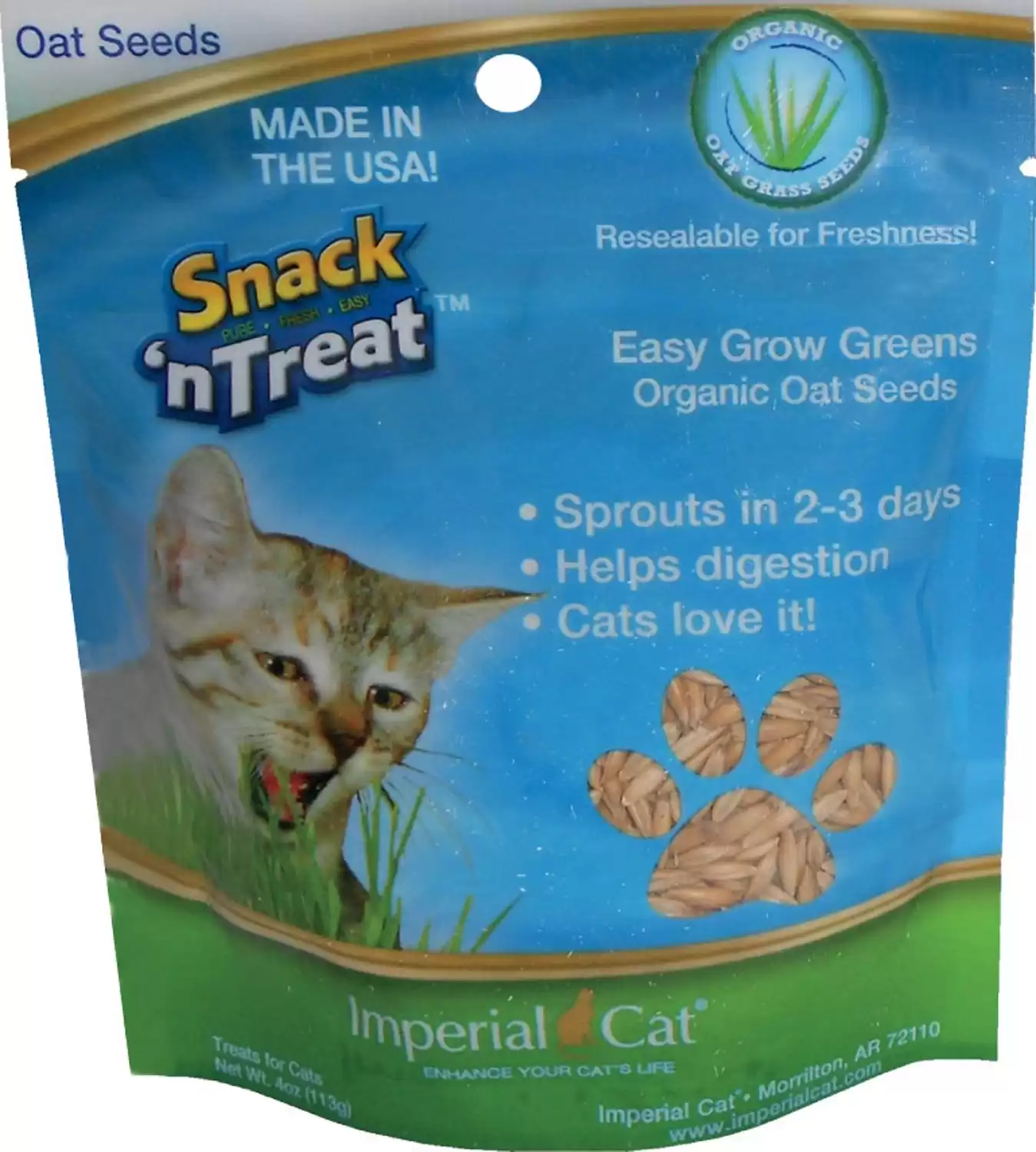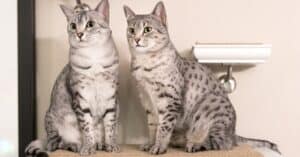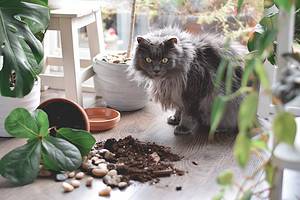Snake plants are a very popular type of houseplant because they’re resilient and easy to care for. But have you ever wondered – are snake plants toxic to cats? Unfortunately, snake plants are actually toxic to cats as well as dogs. Snake plants contain a toxin known as saponin. Saponin is a defensive mechanism for the plant that allows it to protect itself against harmful microbes, fungi, and insects.
If you already own a snake plant, there are a few things you can do to protect your cat and prevent it from ingesting it. There are also many alternatives to snake plants that you could try if you’re looking to swap yours out for a safer variety. Read on to learn more about snake plants and how to keep your cat safe.
What Happens If My Cat Ingests a Snake Plant?
Are snake plants toxic to cats if they just take a tiny bite? Yes, but the less they ingest, the less sick they will be. The first thing that will happen if your cat decides to take a bite out of your snake plant is that when the leaf breaks, the plant will release its toxin known as saponin. As soon as your cat gets some of this substance in its mouth, it will experience a very bitter taste. If the cat goes on to consume any part of the leaves there are a few symptoms that may arise. Be on the lookout for:
- Vomiting
- Nausea
- Depression
- Diarrhea
- Drooling
- Abdominal pain or discomfort
- Loss of appetite
- Swollen mouth or throat
If your cat already suffers from a chronic illness or medical condition, the likelihood of it experiencing more severe symptoms increases. Hopefully, the cat will not attempt to ingest parts of the plant since as soon as it takes a bite, the cat will have a harsh, bitter taste in its mouth from the toxin. Because of this they may only ingest a small amount of the plant (if any) and will likely try to spit the rest out.
Thankfully, if your cat does consume a small amount of saponin it isn’t fatal. If your cat develops any symptoms, they should only last for about 1-2 days. You will still want to be sure to contact your veterinarian and let them know what happened.
You may still want to get your cat seen just to be on the safe side in case it did consume too much of the toxin, or if its symptoms are causing discomfort or pain. You will know if your cat has ingested a larger piece of the snake plant because the symptoms will likely be more severe. If you notice things like swelling or itching, get your cat to the vet right away.
Your vet will examine your cat to determine what needs to be done. If necessary, antihistamines for allergies and other medications may be prescribed. These medicines will help soothe your cat’s irritated stomach and GI tract.
How Do I Stop My Cat From Eating My Snake Plant?
There is no 100% guaranteed way to prevent a cat from eating any houseplant besides removing the plant from your home. However, most people —especially plant lovers, want to have the best of both worlds. There are a few things you can do to try to discourage your cat from playing near your snake plant or from taking a bite out of it. They are as follows:
1. Relocate the Plant
Instead of completely removing the plant from your home, try moving it to another location that’s just outside of your cat’s reach. This might be easier said than done since cats seem to be able to reach just about anything but try keeping the plant in a spot that is away from their eating area, furniture, and litter box.
The best thing you can do is put the snake plant in a room where you’re able to shut the door. That way you can keep the cat out when you’re not there keeping an eye on it. The good thing is that snake plants don’t require a lot of sunlight, so you can place in it a room that doesn’t get much natural light and it should be fine.
2. Place the Plant up Higher
Along with the previous suggestion, you can try placing the snake plant up higher out of your cat’s reach using a stand or an isolated shelf. This creates a level of difficulty for your cat to reach the plant, decreasing the chances that it will make the effort to get to it. Some cats can be quite persistent though, so be sure there isn’t a nearby surface that your cat can climb onto to help it reach the plant.
- Decorative floating shelves
- Set of two
- Made of strong wooden boards
- Hang with jute (included)
- Simply hang the unit from a nail, screw, or hook
3. Make the Plant Smell Unappealing
Another thing you can try is to make your plant smell bad to the cat. A snake plant, toxic to cats, is less appealing if it smells like something your cat hates. Don’t worry, this doesn’t necessarily mean it will smell bad to you or make your home smell bad. Most cats do not enjoy the smell of citrus fruits, so you could use the juice or zest of limes, lemons, and oranges near your plant to help keep it away. Unless you’re also not too fond of citrus, this will only smell repulsive to your cat and it will give your home a nice, fresh, scent.
A bonus is that by spraying citrus on or near your plants, you may also be able to keep certain insects like aphids away. Aphids are pesky insects that can get indoors and quickly become an infestation for your houseplants. And since they have no natural predators inside, they can grow in numbers and become a big problem rather quickly. Making a spray from citrus peels makes a great natural bug killer and is safe to use around your home and pets (they just won’t like the smell).
- Non-toxic
- Safe for plants
- Deters cats with natural rosemary and lemongrass essential oils
- 100% manufacturer's guarantee
4. Spray the Plant With Pet Spray
There are a few different types of pet sprays that are available on the market that you can try using to keep your cat away from your snake plant. These sprays work by discouraging your cat from chewing on certain items.
Most of the flavors taste very bitter to your cat but are not toxic. The sprays come in either bitter apple or citrus flavors. Keep in mind though, that every cat is different and some might not mind the taste of some sprays while particularly hating others. It may take you a few tries to find the right one that your cat despises.
You’ll also want to make sure that you find a spray that’s safe for your plant’s leaves. You can test this by spraying only one small area of your plant’s leaves. Wait a while to see if the spray harms the plant. If not, go ahead and spray the remainder of the plant in accordance with the manufacturer’s recommended frequency. If you want a more natural solution, you can make a mixture containing one part vinegar and three parts water.
5. Give Your Kitty Cat Grass
If your cat loves chewing on leafy things you can try giving it a safer alternative. Cat grass is safe for cats to chew and graze on and is easy to care for and grow. An added plus is that cat grass actually has some beneficial nutrients and fiber that make it a healthy snack.
Cat grass is actually not considered a type of plant, but rather a grass mixture that is grown from seeds such as wheat, rye, barley, or oats. Cat grass is not the same as the grass you’ll find outside in your yard, so you don’t want to mistake the two. It’s not a good idea to let your cat go munching on your lawn. That would most likely lead to an upset stomach or worse if the lawn was treated with pesticides.
Cat grass is a different blend and is grown safely indoors, specifically for household pets. One of the benefits of having cat grass in your home is that it can act as a deterrent, pulling your cat’s attention away from your other houseplants. If your cat is more distracted by the cat grass, it will be less likely to go after your snake plant which is not safe for them like cat grass is.
- Easy-to-grow oat grass seeds
- Grow year-round
- Can help eliminate hairballs
- Organic
- Made in the U.S.A.
6. Provide Your Cat With Other Alternatives for Chewing
Sometimes it’s not that your cat wants to eat your houseplants—it’s that it may need something to chew on in general. Cats love to play and if they lack mental stimulation they will try to get it in just about any way that they can. This includes biting your plants.
If you give them enough chew toys to play with they might not turn towards your houseplants when they’re bored and instead look for their favorite toy. This is especially true if you get one that is infused with catnip.
We all know what catnip does to cats, and if it’s boredom that’s causing your cat to chew on plants, then a catnip toy should do the trick. Not only will it give your cat something else to focus on, but it may also actually help reduce a cat’s anxiety. After a few minutes of playing with a catnip toy, cats usually mellow out and become a lot calmer.
Bonus: Are Spider Plants Toxic to Cats?
Another indoor plant whose name conjures an animal that tends to scare people is the spider plant. You may be wondering whether or not spider plants are toxic. The answer is no, they are not. Spider plants are non-toxic, and safe for your cat to nibble on in moderation. In fact, cats can be drawn to munch because your cat may get a heady rush similar to that from catnip. Some cats gnaw on spider plants to help ease an upset stomach, so unless you want your plant to get mangled, you should put it high.
Below is a list of a few other houseplants that are safe for your cat to investigate and taste:
- Ponytail Palm
- Sword Fern
- Calathea
- African Violets
- Boston Fern
- Parlor Palm
- Orchids
- Cast Iron Plant
- Prayer Plant
The photo featured at the top of this post is © Foto2rich/Shutterstock.com
Thank you for reading! Have some feedback for us? Contact the AZ Animals editorial team.









